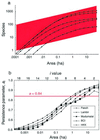Predicting species diversity in tropical forests
- PMID: 11005859
- PMCID: PMC27112
- DOI: 10.1073/pnas.97.20.10850
Predicting species diversity in tropical forests
Abstract
A fundamental question in ecology is how many species occur within a given area. Despite the complexity and diversity of different ecosystems, there exists a surprisingly simple, approximate answer: the number of species is proportional to the size of the area raised to some exponent. The exponent often turns out to be roughly 1/4. This power law can be derived from assumptions about the relative abundances of species or from notions of self-similarity. Here we analyze the largest existing data set of location-mapped species: over one million, individually identified trees from five tropical forests on three continents. Although the power law is a reasonable, zeroth-order approximation of our data, we find consistent deviations from it on all spatial scales. Furthermore, tropical forests are not self-similar at areas </=50 hectares. We develop an extended model of the species-area relationship, which enables us to predict large-scale species diversity from small-scale data samples more accurately than any other available method.
Figures



References
-
- Reid W, Miller K. Keeping Options Alive: The Scientific Basis for Conservation Biology. Washington, DC: World Resources Institute; 1989.
-
- Reid W. In: Tropical Deforestation and Species Extinction. Whitmore T, Sayer J, editors. London: Chapman & Hall; 1992. pp. 55–73.
-
- Simberloff D. In: Dynamics of Extinction. Elliot D, editor. New York: Wiley; 1986. pp. 165–180.
-
- Raven P. In: Biodiversity. Wilson E O, Peter F, editors. Washington, DC: Natl. Acad. Press; 1988. pp. 119–122.
LinkOut - more resources
Full Text Sources

